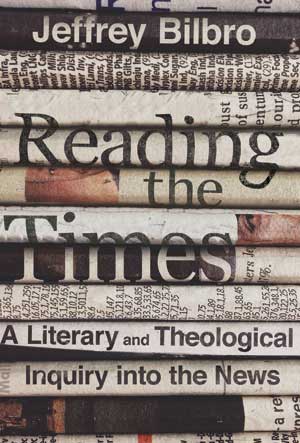A Review of "Reading the Times: A Literary and Theological Inquiry into the News" by Jeffrey Bilbro
Media theorist Neil Postman once observed that we no longer live in an age of information scarcity; our real problem is information glut. Like the Sorcerer's Apprentice, "we are awash in information, without even a broom to help us get rid of it." In an essay in First Things, Postman quotes from a poem by Edna St. Vincent Millay:
Upon this gifted age, in its dark hour,
Rains from the sky a meteoric shower
Of facts . . . they lie unquestioned, uncombined.
Wisdom enough to leech us of our ill
Is daily spun, but there exists no loom
To weave it into fabric.
Henry David Thoreau would have been sympathetic to these lines, for he believed it was possible to become blinded when there was too much to see: "I believe that the mind can be permanently profaned by the habit of attending to trivial things, so that all our thoughts shall be tinged with triviality."

Chesterton learned to practice what he called sancta indifferentia, or "holy indifference," which means to learn to leave events in God's hands. The theological implication of sancta indifferentia is realizing that despite what happens in this troubled world, the Cross cannot be defeated—because it is defeat. We were not made to bear the weight of the entire world, which now comes to us in massive quantities 24/7. Only one Person could bear such a burden and, in fact, did bear it.
Proper Calibration
Bilbro says that all current events—all chronological events—must be calibrated to that earth-stopping event that took place over 2,000 years ago. Our own lives are now grounded in the Christ event, which Christians have traditionally measured in rhythmic, cyclical, or seasonal time as expressed in the church calendar. Inspired by the figural imagination of Dante, Bilbro says that a proper theology of the news needs to locate events in the "grand architecture of heaven."
The decentralization of the news means that our uncle's Facebook page has been put on equal footing with all other news. However, what happens when the news from our particular media bubble contradicts the news from a competing media bubble? More importantly, what happens to democratic institutions when their citizens cannot even agree on the "facts"?
Bilbro says that when societal concord is no longer supported by a functional public-info-sphere, flesh-and-blood communities of family, church, and neighborhood must step in to take up the slack. He would have us support what he calls "redemptive publishing," for which magazines like this one serves as an example. Cause-journalism modeled after older newspapers like Frederick Douglass's North Star and Dorothy Day's Catholic Worker, but now exemplified by institutions like The Front Porch Republic, Mere Orthodoxy, and Hedgehog Review, also provide opportunities to foster community and reflect upon current events.
A proper theology of the news, then, means giving our attention to what is important and realizing that vertical time is the key to interpreting horizontal time, while also strengthening our ties with nurturing communities. Only then can we begin to weave a coherent pattern amid a meteoric shower of disconnected facts.
Arthur W. Hunt III Get Salvo in your inbox! This article originally appeared in Salvo, Issue #60, Spring 2022 Copyright © 2025 Salvo | www.salvomag.com https://salvomag.com/article/salvo60/a-theology-of-the-news


















